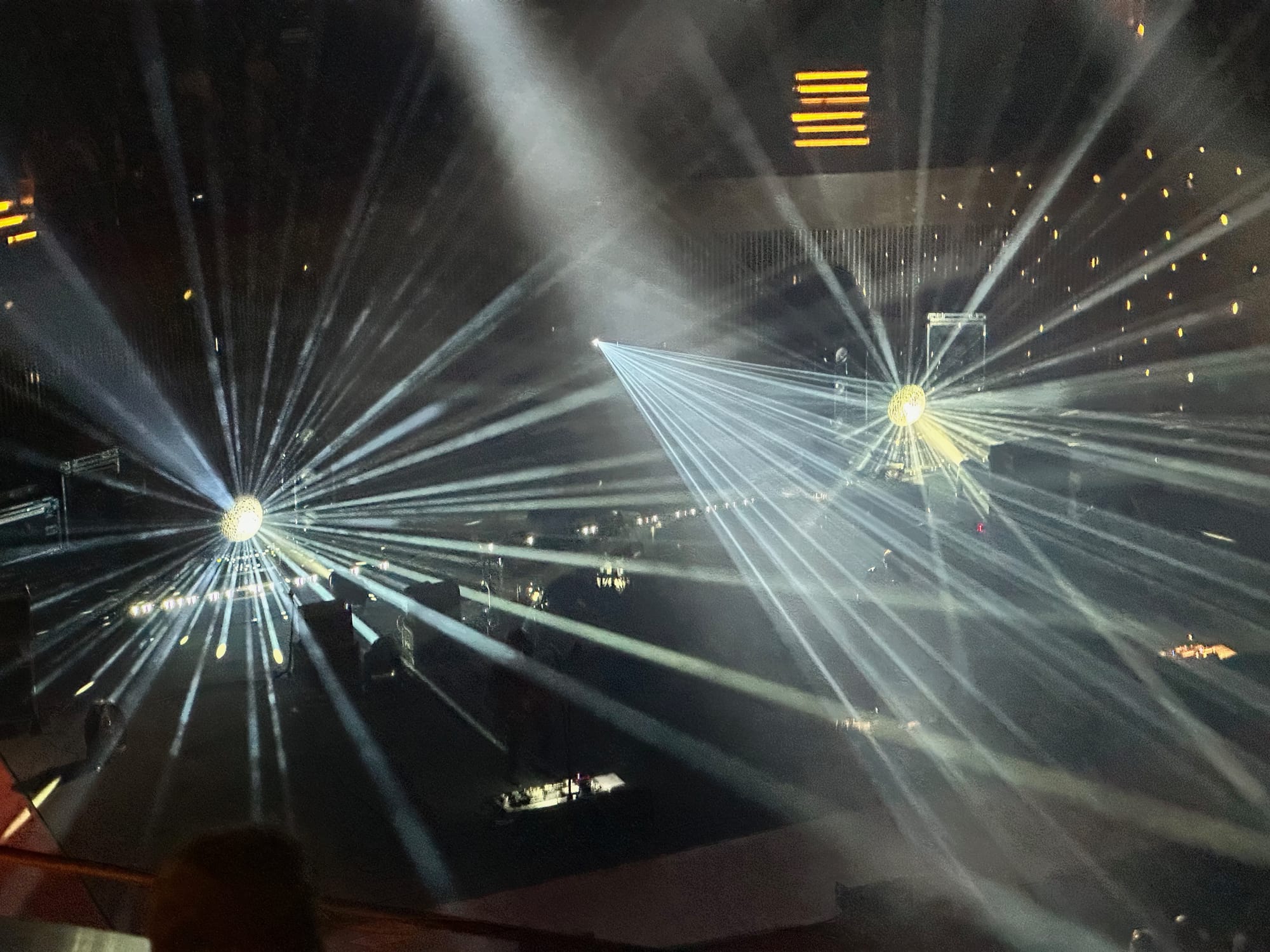Monthnotes: November 2024

Every ten days or so, I share a quick digest of what I've been working on and reading. Here's the latest. More in the series here.
You might be pleased to hear that there's no politics in this one. It's a bad time, isn't it? The only way I can get anything done is to stay in "head-in-sand" mode. Undoubtedly linked to that, I'm feeling like I'm starting to move from primarily "output" to primarily "input" in my work. I used to freak out when this happens, thinking I was out of ideas forever. But then I read Austin Kleon's writing about creative seasons in his book Keep Going, and now I'm able to relax into it instead and trust my future self to do something useful with the stuff I'm feeding it.

That said, it has been kind of an output-heavy time lately, and so that's the balance in this newsletter too. Last time I mentioned On Standby - the long sonification / radio documentary / sound art piece that I've been working on, funded by a grant I applied for back in June.

The whole project is expansive in scope, but the elevator pitch version is that it's a 10h40m piece of music, designed to be slept to, created from data collected by seven volunteers about the overnight energy use of devices in their home, interspersed occasionally with with quiet, calm interviews and poetry. You can get a sense of the vibe by watching this one-minute trailer, and read a longer a description on the Loud Numbers website.
The good news: It's done! Finished! Produced, mixed, mastered, uploaded to streaming services, and ready to go. We've scheduled a bunch of playback dates, starting with a couple of broadcasts on community radio stations. Here's the list, covering as many timezones as we could realistically manage:
2024-11-29 @ 10pm Sweden time (UTC+1): NGBG Radio
2024-11-29 @ 10pm UK time (UTC): Soundart Radio
2024-12-02 @ 10pm Europe time (UTC+1): YouTube Live
2024-12-03 @ 10pm Chicago time (UTC-5): YouTube Live
2024-12-05 @ 10pm Beijing time (UTC+8): YouTube Live
The piece will be on Bandcamp and streaming services from 9 December, but the best way to listen is to catch one of these broadcasts. So put your favourite one in your calendar, and I'll see you there.
I think I've mentioned before that I've been working for a while on starting up a sonification awards programme. I've always found traditional awards programmes frustrating because they're inherently competitive. There can only ever be one "grand prize winner", no matter how much good work is made in any given year, and so it doesn't feel like a great way to build a community and encourage the creation of good work.
So instead, we've taken a different approach. We’ve worked together with the community to put together criteria for what makes an "excellent sonification" in three categories - art, communication, and analysis. Every sonification submitted that is judged to meet the criteria in its category will be an equal winner. Esentially it's more like a Michelin star than an Oscar.
Any sonification that was released in the last two years is eligible for entry. The deadline for submissions is the end of the year. Check out the criteria and submit your work at sonificationawards.org.

We’re also looking for people to volunteer to be judges. The only criteria there is that you need to have created and published at least one sonification. Otherwise you're good to go, no matter how qualified or unqualified you feel. Sign up here.

Two reports were published this month that I worked on. The first is for Possible and is about how the lack of diversity in how cyclists are depicted impacts its popularity. The report is here, it was covered in Forbes here, and here's some blurb:
Our research shows there is a significant lack of diversity found in cycling imagery, both in terms of people who cycle and the types of cycling that is depicted. Our systematic review shows that images of bike users show predominantly white, slim and non-disabled folk and heterosexual nuclear families, and that the activity is undertaken in quiet rural locations (without buildings, motor traffic, pedestrians or cycle infrastructure).

I also worked on a report for Rethinking Economics about the extent to which university economics courses cover real-world, future-facing topics. You can find the report here, and here's some blurb:
The first quarter of the 21st century has seen seismic shifts in the politics, society and economy of the United Kingdom. As economics thinkers and graduates, Rethinking Economics is concerned that economics education remains out of step with these shifts. What is taught in university classrooms informs how society perceives and will tackle these challenges: from engaging in climate science to the reality of Britain’s colonial past. This report assesses the extent to which university education in this country is equipping students for their future by looking at the education at twenty universities. It does this through analysis of module and course descriptions and with the support of students based at the universities under review.

Final bit of output for this month - earlier this year I worked on a visualization for Scientific American magazine, and the issue has just been released so I can finally talk about it.
It's a visual summary of a scientific paper which gathered together recordings of folk songs from all kinds of cultures around the world, comparing them to recordings of speech from the same cultures to see how the two differ, and whether those differences are consistent from culture to culture.
Here's a snippet:
Ozaki and a large team of collaborators compared samples of songs and speech from around the world. These categories can vary wildly across cultures: songs can be lilting lullabies or rhythmic chants or wailing laments, and some spoken languages have more “musical” qualities, such as tonal languages, which convey meaning through pitch. Despite this variation, the researchers found three worldwide trends: songs tend to be slower than speech, with higher and slightly more stable pitches. These consistent differences suggest that singing isn’t just a by-product of speech, yet why it evolved is still unknown.
We developed a collection of visualizations to show this - a map of the language locations, a bunch of slopecharts for speed, pitch and stability, and then a deep dive into two recordings in particular - sung and spoken versions of the folk song Scarborough Fair.

The hardest bit here wasn't the chart itself, but the y-axis which we wanted to show as a piano keyboard. You might know that frequency doubles every time you go up an octave of pitch, so it's already not a linear relationship. But additionally and awkwardly, piano keyboards are laid out with the white keys taking up equal space and the black keys fitting in between some of them. So to get the axis to be linear in pitch terms - making both white and black notes equal - we had to widen some of the white notes. If all that was very confusing to you, then I don't recommend ever trying to make a piano keyboard axis yourself.
Anyway. We solved it, and the whole piece is looking beautiful in the magazine. It's also online here. If you don't have a subscription, then give this link a try instead.

That's enough Duncan-produced things. What have I been putting into my brain?
I'm about two thirds of the way through Moonbound - the latest novel from Robin Sloan. It's a delightful bit of speculative fiction set in 11,000 years, long after an AI apocalypse wiped humans off the planet, or so they thought. It's pacey, imaginative, and full of wonderful little vignettes that explore interesting ideas in juuuust enough depth. There are a few places where I kinda wish it would go deeper, rather than zipping on to the next thing. But that frustration is easily outweighed by the high rates of delight delivery.

I'm also about two thirds of the way through my first playthrough of Satisfactory, which is a first-person factory-building game set on an alien planet. It's kind of like Minecraft, in that it's all about exploring, crafting and building. But it's different (and more similar to the many Minecraft tech modpacks) in that the point of the game is to build systems that automate the boring bits for you. It spent years and years in early access, meaning that the recent 1.0 release is totally polished and an absolute joy to play. I've spent 60-odd hours on it to date, fiddling with conveyor belts, climbing to the tops of the beautiful scenery and hunting down slugs, and I don't regret it for a moment.

Then last weekend, I also finished my annual autumnal re-watch of Over the Garden Wall. I've seen it four times or so now, and every time I find it a total delight. It manages to be both adorable and unsettling at the same time, and features a stellar voice acting cast - including Elijah Wood, Christopher Lloyd, John Cleese, and Tim Curry. The animation is wonderful, the characters are great, and the music is perfect. Go watch it. If, er, you can still find it on your streaming service of choice.

That's it. Enjoy the darkening nights, and let's talk again in December.
- Duncan











